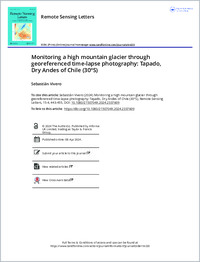Monitoring a high mountain glacier through georeferenced time-lapse photography: Tapado,
Dry Andes of Chile (30°S)
DOKPE
- Vivero, Sebastián ORCID University of Fribourg
- 2024
Published in:
- Remote Sensing Letters. - UK : Taylor and Francis Group. - 2024, vol. 15, no. 4, p. 443-455
English
Glaciers and snow cover provide freshwater for irrigated agriculture and urban consumption in the Dry Andes. Given the aridity of this environment, sublimation losses are significant, making precise monitoring techniques crucial in estimating glacier changes. Continuous monitoring of glaciers is typically conducted through the use of automatic weather stations (AWS). However, these stations may not capture the full extent of glacier changes, warranting the use of additional monitoring techniques such as close-range remote sensing and satellite imagery. This study utilizes time-lapse photography acquired from 2013 to 2015 to examine the temporal and spatial albedo variations across the Tapado Glacier, along with the surface changes in the debriscovered section. Sequential orthorectified images were used to observe the spatial evolution of ice cliffs and supraglacial ponds as they changed over time. High-resolution displacement measurements were obtained using feature tracking methods on the debris-covered glacier. Additionally, distributed albedo maps were produced by comparing photographic data with point albedo measurements from an AWS. The results indicate decreased albedo values during summer, along with the expansion of supraglacial ponds and ice cliffs in the debris-covered region. The study also proposes a cost-effective remote site monitoring approach using time-lapse photography for continuous observation and data collection.
- Faculty
- Faculté des sciences et de médecine
- Department
- Département de Géosciences
- Language
-
- English
- Classification
- Earth sciences
- License
- Open access status
- hybrid
- Identifiers
-
- DOI 10.1080/2150704X.2024.2337609
- ISSN 2150-704X
- ISSN 2150-7058
- Persistent URL
- https://folia.unifr.ch/unifr/documents/328447
Statistics
Document views: 114
File downloads:
- monitoringahighmountainglacier: 164
